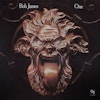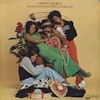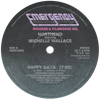LISTEN
Listen to the record below.
READ
In the aftermath of World War II, U.S. Army Air Corpsman and music teacher Harold Rhodes developed a simple, portable piano designed for recovering GIs to play in hospital beds. He couldn’t have known then that a descendant of his humble invention would be a central component of a massively influential musical movement, but by the early 1970s, his design had been refined and commodified, and the distinctive sound of the Fender Rhodes electric piano was heard everywhere. It was ubiquitous—from nightclubs to pop radio, and nowhere more so than in the sophisticated new style of jazz being popularized by the artists on the CTI record label. Records from Grover Washington Jr., Hubert Laws, and Quincy Jones were a few of the first to utilize this fresh new tone, all courtesy of a young keyboardist and arranger from the Midwest named Bob James.
James first came to the attention of the jazz world at large when he won a competition at the Notre Dame Jazz Festival in 1963. One of the judges was up-and-coming producer and arranger Quincy Jones. Taken with James’s style and technique, Jones actively promoted him, getting the youngster signed to Mercury Records where the very first Bob James LP, Bold Conceptions, was released that same year. By the mid-’60s, James was touring and recording with Sarah Vaughan, a prestigious position to be sure, but one which gave little hint of what would soon follow.
Meanwhile, Creed Taylor, a musical visionary famed as a producer with Verve and the founder of Impulse! Records, was embarking on a new venture. Taylor wanted to bring jazz to a wider audience and had a well-conceived plan to do it. He would add lush production values more in line with pop music, including brass and string sections. He would focus on hip interpretations of popular music and familiar classical melodies. The packaging of his albums would be glossy, with artistic photos and gatefold jackets. And the core musicians would be specialists in the new electric sound who could hold down the heaviest grooves.
One of Taylor’s first releases on his new label, christened Creed Taylor Incorporated, or CTI, was an LP by his good friend Quincy Jones. Jones brought Bob James on board as a keyboard player and gave him arranging credit on one of the tunes, a significant statement considering Jones’s sizable reputation as an arranger himself. Walking in Space, released in 1969, was a landmark for James in two regards: it brought him to the clear attention of Creed Taylor as an arranger and marked the first time James used an electric piano on record.
The electric piano in question did not belong to James, however, and he had barely used one before arriving at Rudy Van Gelder’s studio, where Walking in Space was recorded. “I was a sideman and was asked to do it,” he recalled when we talked in 2013. “I never set out to say that I was going to be identified with the Fender Rhodes piano.” In fact, he wasn’t initially fond of the sound. “Some of my favorite piano players occasionally would use the Rhodes—Oscar Peterson, Bill Evans—and I was quite critical of the way they played it, because I could tell that they weren’t really embracing it as a musical instrument. It was a novelty and they sounded clumsy on it, to my ears.” James tried to develop a touch that would take advantage of the sounds that could be coaxed from the Rhodes by playing more subtly. “If I used the same technique that I would use on the acoustic piano, it was too heavy and sounded clunky and awkward,” he explained. When James arrived at Van Gelder’s studio in 1969 and was asked to use this new device, he was determined to not repeat the mistakes of his predecessors and forge his own style on the instrument. “Maybe that approach contributed to the fact that people liked hearing me play the Rhodes.”
The Bob James style, refined over an enormous number of sessions through the next decade—most recorded at Van Gelder’s studio—would influence a generation of musicians and mark a definite sea change in popular instrumental music. “There was a shift in jazz,” James explained, “moving away from the swing-based feel that had been standard up to that time and towards a more modal way of playing.” This groove-based approach was certainly intentional on the part of Creed Taylor, who with CTI was making a deliberate play for the fans of funk and R&B who wanted a bit more of the sophistication associated with the jazz and classical idioms. “Rock rhythms were also starting to find their way into jazz songs,” James said. “We were playing even sixteenth-note grooves as opposed to swing.” This funkier feel was de rigueur on CTI releases, as was a liberal sprinkling of covers of popular R&B and rearranged versions of classical standards—both of which would make appearances when in 1974 Bob James finally got the opportunity to record his first record as a leader since 1965’s Explosions.
Recorded at Van Gelder Studios, Bob James’s One finally brought into focus a group of stellar musicians who, under the direction of their leader, by then renowned for his unique touch on the electric piano, would record an undisputed jazz-funk classic.
“Valley of the Shadows” leads off the album, a complicated song that challenges the listener right off the bat with multiple contrasting movements. The improvisation within the framework of James’s composition sets up numerous absorbing moments between the rhythm section of bassist Gary King, drummer Steve Gadd, and James’s keyboard. “These guys were amazing,” James said. “Gary King was like the Rock of Gibraltar, I had supreme confidence that he was right at the bottom of every groove.” Hip-hop production luminaries DJ Premier and, appropriately, DJ Shadow have found much to admire in this piece of baroque funk.
Perfect illustrations of Creed Taylor’s policy of cover versions, “Feel Like Making Love,” “Night On Bald Mountain,” and “Soulero”—a funked up arrangement of, you guessed it, Ravel’s “Bolero”—were pushed to radio, with mild success. But lurking in the final slot on the B-side of One, a space traditionally reserved for cuts with little commercial potential, was a track built around a relentless, off-kilter, menacing seven-note riff. “Nobody paid any attention to it,” James recalled. “I didn’t think it had any kind of hook at all that was special.” Despite James’s initial appraisal, at some point in the ’70s amateur DJs in the parks of New York City—the DJs who were unknowingly soundtracking the birth of hip-hop—began playing it, focusing on Idris Muhammad’s massive drum break. “Idris’s groove was awesome,” James admitted. “It was so simple and so catchy, it was irresistible.” As sampling became prevalent in the exploding hip-hop scene of the mid-’80s, the song, which Creed Taylor named “Nautilus” for its submarine-dive intro and deep, undersea mood, was repeatedly plundered, with virtually every loopable bit of its five-minute duration being used in one song or another. The mesmerizing, slowly unwinding keyboard solo that takes up the middle portion is a perfect example of James’s special touch on the Rhodes, and an apt reminder of how far we’d come from Harold Rhodes’s simple invention.
SAMPLE BREAKDOWN
Tracklib—the world's first and only sample clearance platform—created these animations to help bring sampling to life. Below you'll see how “Nautilus” is sampled to create “Murray's Revenge” by MURS & 9th Wonder. To find out more head to tracklib.com, and if you want to discover more of the sample breakdowns then head over to their YouTube channel to watch them all. You won't be disappointed.


